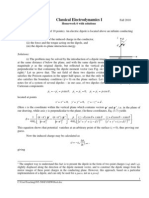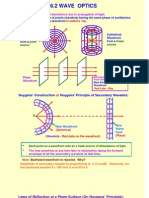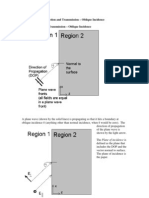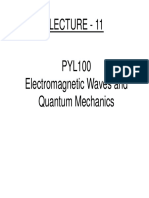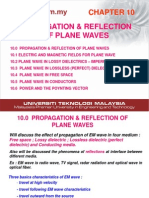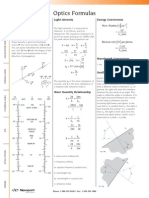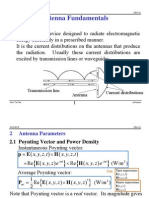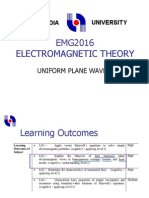Fresnel's Equations For Reflection and Transmission: Incident, Transmitted, and Reflected Beams
Uploaded by
Jeffrey PhelpsFresnel's Equations For Reflection and Transmission: Incident, Transmitted, and Reflected Beams
Uploaded by
Jeffrey Phelps13.
Fresnel's Equations for Reflection
and Transmission
Incident, transmitted, and reflected beams
Boundary conditions: tangential fields are continuous
Reflection and
transmission
coefficients
The "Fresnel Equations"
Brewster's Angle
Total internal reflection
Power reflectance
and transmittance
Augustin Fresnel
1788-1827
Posing the problem
What happens when light, propagating in a
uniform medium, encounters a smooth interface
which is the boundary of another medium with a
different refractive index?
k-vector of the
incident light
boundary
n
incident
n
transmitted
First we need to
define some
terminology.
Definitions: Plane of Incidence and
plane of the interface
Plane of incidence (in this
illustration, the yz plane) is the
plane that contains the incident
and reflected k-vectors.
x
y
z
Plane of the interface (y=0, the xz plane) is the plane that
defines the interface between the two materials
Definitions: S and P polarizations
2. Ppolarization is the parallel
polarization, and it lies parallel
to the plane of incidence.
1. Spolarization is the perpendicular polarization, and
it sticks up out of the plane of incidence
The plane of the interface (y=0)
is perpendicular to the page.
Here, the plane of
incidence (z=0) is the
plane of the page.
x
y
z
I
R
T
A key question: which way is the E-field pointing?
There are two possibilities.
reflected light
reflecting medium
Definitions: S and P polarizations
The amount of reflected (and transmitted) light is
different for the two different incident polarizations.
n
i
n
t
i
k
r
k
t
k
u
i
u
r
u
t
E
i
B
i
E
r
B
r
E
t
B
t
Interface
x
y
z
Beam geometry for
light with its electric
field sticking up out of
the plane of incidence
(i.e., out of the page)
We treat the case of s-polarization first:
the xz plane (y = 0)
A. Fresnel was the first to do this calculation (early 1800s).
Fresnel EquationsPerpendicular E field
n
i
n
t
i
k
r
k
t
k
u
i
u
r
u
t
E
i
B
i
E
r
B
r
E
t
B
t
Interface
Boundary Condition for the Electric
Field at an Interface: s polarization
x
y
z
In other words,
The Tangential Electric Field is Continuous
So: E
i
(y= 0) + E
r
(y= 0) = E
t
(y= 0)
The component of
the E-field that lies in
the xz plane is
continuous as you
move across the
plane of the interface.
Here, all E-fields are
in the z-direction,
which is in the plane
of the interface.
(Were not explicitly writing
the x, z, and t dependence,
but it is still there.)
Boundary Condition for the Magnetic
Field at an Interface: s polarization
n
i
n
t
i
k
r
k
t
k
u
i
u
r
u
t
E
i
B
i
E
r
B
r
E
t
B
t
Interface
x
y
z
u
i
u
i
*It's really the tangential B/, but we're using
i
=
t
=
0
B
i
(y= 0) cosu
i
+ B
r
(y= 0) cosu
r
= B
t
(y= 0) cosu
t
The Tangential Magnetic Field* is Continuous
In other words,
The total B-field in the
plane of the interface is
continuous.
Here, all B-fields are in
the xy-plane, so we take
the x-components:
Reflection and Transmission for
Perpendicularly Polarized Light
Ignoring the rapidly varying parts of the light wave and keeping
only the complex amplitudes:
0 0 0
0 0 0
cos( ) cos( ) cos( )
+ =
+ =
i r t
i i r r t t
E E E
B B B u u u
0 0 0 0
0 0 0 0
:
( )cos( ) ( )cos( )
Substituting for using + =
= +
t i r t
i r i i t r i t
E E E E
n E E n E E u u
0 0 0
( )cos( ) cos( ) =
i r i i t t t
n E E nE u u
0 0
/( / ) / . But and = = =
i r
B E c n nE c u u
Substituting into the second equation:
Reflection & Transmission Coefficients
for Perpendicularly Polarized Light
| | | |
0 0 0 0
0 0
( )cos( ) ( )cos( ) :
cos( ) cos( ) cos( ) cos( )
i r i i t r i t
r i i t t i i i t t
n E E n E E
E n n E n n
u u
u u u u
= +
+ =
Rearranging yields
| |
0 0
/ 2 cos( )/ cos( ) cos( )
t i i i i i t t
t E E n n n u u u
= = +
0 0
/ , is
t i
E E Analogously, the transmission coefficient,
| | | |
0 0
/ cos( ) cos( ) / cos( ) cos( )
r i i i t t i i t t
r E E n n n n u u u u
= = +
0 0
/
r i
E E Solving for yields the reflection coefficient:
These equations are called the Fresnel Equations for
perpendicularly polarized (s-polarized) light.
n
i
n
t
i
k
r
k
t
k
u
i
u
r
u
t
E
i
B
i
E
r
B
r
E
t
B
t
Interface
Fresnel EquationsParallel electric field
x
y
z
Beam geometry
for light with its
electric field
parallel to the
plane of incidence
(i.e., in the page)
Note that the reflected magnetic field must point into the screen to
achieve for the reflected wave. The x with a circle
around it means into the screen.
E B k
Note that Hecht
uses a different
notation for the
reflected field,
which is confusing!
Ours is better!
This leads to a
difference in the
signs of some
equations...
Now, the case of P polarization:
Reflection & Transmission Coefficients
for Parallel Polarized Light
These equations are called the Fresnel Equations for
parallel polarized (p-polarized) light.
| | | |
|| 0 0
/ cos( ) cos( ) / cos( ) cos( )
r i i t t i i t t i
r E E n n n n u u u u = = +
| |
|| 0 0
/ 2 cos( )/ cos( ) cos( )
t i i i i t t i
t E E n n n u u u = = +
Solving for E
0r
/ E
0i
yields the reflection coefficient, r
||
:
Analogously, the transmission coefficient, t
||
= E
0t
/ E
0i
, is
For parallel polarized light, B
0i
B
0r
= B
0t
and E
0i
cos(u
i
) + E
0r
cos(u
r
) = E
0t
cos(u
t
)
To summarize
||
cos( ) cos( )
cos( ) cos( )
=
+
i t t i
i t t i
n n
r
n n
u u
u u
||
2 cos( )
cos( ) cos( )
=
+
i i
i t t i
n
t
n n
u
u u
2 cos( )
cos( ) cos( )
=
+
i i
i i t t
n
t
n n
u
u u
cos( ) cos( )
cos( ) cos( )
=
+
i i t t
i i t t
n n
r
n n
u u
u u
s-polarized light: p-polarized light:
And, for both polarizations:
sin( ) sin( ) =
i i t t
n n u u
p
la
n
e
o
f
in
c
id
e
n
c
e
incident
wave
transmitted wave
interface
p
la
n
e
o
f
in
c
id
e
n
c
e
incident
wave
transmitted wave
interface
E-field vectors are red.
k vectors are black.
Reflection Coefficients for an
Air-to-Glass Interface
Incidence angle, u
i
R
e
f
l
e
c
t
i
o
n
c
o
e
f
f
i
c
i
e
n
t
,
r
1.0
.5
0
-.5
-1.0
r
||
r
0 30 60 90
The two polarizations are
indistinguishable at u = 0
Total reflection at u = 90
for both polarizations.
n
air
~ 1 < n
glass
~ 1.5
Brewsters angle
r
||
=0!
Zero reflection for parallel
polarization at 56.3
Brewster's angle
The value of this angle
depends on the value of
the ratio n
i
/n
t
:
u
Brewster
= tan
-1
(n
t
/n
i
)
Sir David Brewster
1781 - 1868
Incidence angle, u
i
R
e
f
l
e
c
t
i
o
n
c
o
e
f
f
i
c
i
e
n
t
,
r
1.0
.5
0
-.5
-1.0
r
||
r
0 30 60 90
Brewsters
angle
Total internal
reflection
Critical
angle
Critical
angle
Total internal reflection
above the " critical angle"
u
crit
sin
-1
(n
t
/n
i
)
~ 41.8 for glass-to-air
n
glass
> n
air
(The sine in Snell's Law
can't be greater than one!)
Reflection Coefficients for a
Glass-to-Air Interface
Reflectance (R)
R Reflected Power / Incident Power
r r
i i
I A
I A
=
Because the angle of incidence = the angle of reflection,
the beams area doesnt change on reflection.
Also, nis the same for both incident and reflected beams.
A= Area
2
0 0
0
2
c
I n E
c
| |
=
|
\ .
u
i
w
i
n
i
n
t
u
r
w
i
2
R r =
So: since
2
0 2
2
0
=
r
i
E
r
E
Transmittance (T)
t t
i i
I A
I A
=
A= Area
2
0 0
0
2
c
I n E
c
| |
=
|
\ .
cos( )
cos( )
t t t
i i i
A w
A w
u
u
= =
u
t
u
i
w
i
w
t
n
i
n
t
If the beam
has width w
i
:
2
0 0
2
0
0 2
2
2
0 0
0
0
2
2
t t
t t t
t t t t t
i i i i i
i i i
i i
c
n E
n E w
I A w nw
T t
c
I A w nw
n E w
n E
c
c
| |
|
(
\ .
= = = =
(
| |
|
\ .
The beam expands (or contracts) in one dimension on refraction.
since
2
0 2
2
0
t
i
E
t
E
=
( ) ( )
( ) ( )
2
cos
cos
t t
i i
n
T t
n
u
u
(
=
(
(
T Transmitted Power / Incident Power
Reflectance and Transmittance for an
Air-to-Glass Interface
Note that it is NOT true that: r + t = 1.
But, it is ALWAYS true that: R + T = 1
Perpendicular polarization
Incidence angle, u
i
1.0
.5
0
0 30 60 90
R
T
Parallel polarization
Incidence angle, u
i
1.0
.5
0
0 30 60 90
R
T
Brewsters
angle
Perpendicular polarization
Incidence angle, u
i
1.0
.5
0
0 30 60 90
R
T
Reflectance and Transmittance for a
Glass-to-Air Interface
Parallel polarization
Incidence angle, u
i
1.0
.5
0
0 30 60 90
R
T
Note that the critical angle is the same for both polarizations.
And still, R + T = 1
Reflection at normal incidence, u
i
= 0
2
t i
t i
n n
R
n n
| |
=
|
+
\ .
( )
2
4
t i
t i
nn
T
n n
=
+
When u
i
=0, the Fresnel
equations reduce to:
For an air-glass interface (n
i
=1and n
t
=1.5),
R= 4% and T = 96%
The values are the same, whichever
direction the light travels, from air to
glass or from glass to air.
This 4% value has big implications
for photography.
lens flare
Windows look like mirrors at night
(when youre in a brightly lit room).
One-way mirrors (used by police to
interrogate bad guys) are just partial
reflectors (actually, with a very thin
aluminum coating).
Disneyland puts ghouls next to you in
the haunted house using partial
reflectors (also aluminum-coated one-
way mirrors).
Smooth surfaces can produce pretty
good mirror-like reflections, even
though they are not made of metal.
Where youve seen Fresnels Equations in action
Optical fibers only
work because of total
internal reflection.
Fresnels Equations in optics
R=100%
R=90%
Laser medium
0% reflection!
0% reflection!
Many lasers use Brewsters
angle components to avoid
reflective losses:
You might also like
- Fresnel's Equations For Reflection and Refraction: Incident, Transmitted, and Reflected BeamsNo ratings yetFresnel's Equations For Reflection and Refraction: Incident, Transmitted, and Reflected Beams19 pages
- Fresnel's Equations For Reflection and Refraction: Incident, Transmitted, and Reflected BeamsNo ratings yetFresnel's Equations For Reflection and Refraction: Incident, Transmitted, and Reflected Beams19 pages
- Electromagnetic (E-M) Theory of Waves at A Dielectric InterfaceNo ratings yetElectromagnetic (E-M) Theory of Waves at A Dielectric Interface24 pages
- Fresnel's Equations For Reflection and RefractionNo ratings yetFresnel's Equations For Reflection and Refraction46 pages
- EM Waves in Material Media: 1 Wave PropagationNo ratings yetEM Waves in Material Media: 1 Wave Propagation8 pages
- Fresnel Relations: Phys 531 13 September 2005No ratings yetFresnel Relations: Phys 531 13 September 200516 pages
- The Fresnel Equations and Brewster's Law: Equipment100% (1)The Fresnel Equations and Brewster's Law: Equipment6 pages
- Interaction of Light and Matter: 8.1 Electromagnetic Waves at An InterfaceNo ratings yetInteraction of Light and Matter: 8.1 Electromagnetic Waves at An Interface34 pages
- Chapter 22: Electric Fields: Example Questions & ProblemsNo ratings yetChapter 22: Electric Fields: Example Questions & Problems4 pages
- What Is A Wave? Forward vs. Backward Propagating Waves The One-Dimensional Wave EquationNo ratings yetWhat Is A Wave? Forward vs. Backward Propagating Waves The One-Dimensional Wave Equation22 pages
- Electromagnetic Waves: Electromagnetic Wave at The Interface Between Two Dielectric MediaNo ratings yetElectromagnetic Waves: Electromagnetic Wave at The Interface Between Two Dielectric Media15 pages
- Wave Solution in Conducting Medium 2003No ratings yetWave Solution in Conducting Medium 200311 pages
- ECE 3300 Wave Reflection and Transmission - Oblique Incidence Wave Reflection and Transmission - Oblique IncidenceNo ratings yetECE 3300 Wave Reflection and Transmission - Oblique Incidence Wave Reflection and Transmission - Oblique Incidence6 pages
- Module III: Relativistic ED: Applications: Lectures 10-11: Radiation From Circular Orbits: SynchrotronNo ratings yetModule III: Relativistic ED: Applications: Lectures 10-11: Radiation From Circular Orbits: Synchrotron26 pages
- Fresnel's Equations For Reflection and RefractionNo ratings yetFresnel's Equations For Reflection and Refraction37 pages
- Detailed Solution of IES 2103 (ECE) Objective Paper - I: Set - A'No ratings yetDetailed Solution of IES 2103 (ECE) Objective Paper - I: Set - A'12 pages
- Propagation & Reflection of Plane WavesNo ratings yetPropagation & Reflection of Plane Waves32 pages
- Polarisation of EM Waves: Linear and Circular PolarisationNo ratings yetPolarisation of EM Waves: Linear and Circular Polarisation12 pages
- Drift-Diffusion Model: Introduction: Dragica VasileskaNo ratings yetDrift-Diffusion Model: Introduction: Dragica Vasileska9 pages
- O Molecules in It Dont Just Disintegrate, WhyNo ratings yetO Molecules in It Dont Just Disintegrate, Why6 pages
- Pile Driving Analysis & Dynamic Pile Testing100% (2)Pile Driving Analysis & Dynamic Pile Testing88 pages
- Intensity of Electromagnetic Waves as a Function of Frequency, Source Distance and Aperture AngleFrom EverandIntensity of Electromagnetic Waves as a Function of Frequency, Source Distance and Aperture AngleNo ratings yet
- Fresnel's Equations For Reflection and Refraction: Incident, Transmitted, and Reflected BeamsFresnel's Equations For Reflection and Refraction: Incident, Transmitted, and Reflected Beams
- Fresnel's Equations For Reflection and Refraction: Incident, Transmitted, and Reflected BeamsFresnel's Equations For Reflection and Refraction: Incident, Transmitted, and Reflected Beams
- Electromagnetic (E-M) Theory of Waves at A Dielectric InterfaceElectromagnetic (E-M) Theory of Waves at A Dielectric Interface
- The Fresnel Equations and Brewster's Law: EquipmentThe Fresnel Equations and Brewster's Law: Equipment
- Interaction of Light and Matter: 8.1 Electromagnetic Waves at An InterfaceInteraction of Light and Matter: 8.1 Electromagnetic Waves at An Interface
- Chapter 22: Electric Fields: Example Questions & ProblemsChapter 22: Electric Fields: Example Questions & Problems
- What Is A Wave? Forward vs. Backward Propagating Waves The One-Dimensional Wave EquationWhat Is A Wave? Forward vs. Backward Propagating Waves The One-Dimensional Wave Equation
- Electromagnetic Waves: Electromagnetic Wave at The Interface Between Two Dielectric MediaElectromagnetic Waves: Electromagnetic Wave at The Interface Between Two Dielectric Media
- ECE 3300 Wave Reflection and Transmission - Oblique Incidence Wave Reflection and Transmission - Oblique IncidenceECE 3300 Wave Reflection and Transmission - Oblique Incidence Wave Reflection and Transmission - Oblique Incidence
- Module III: Relativistic ED: Applications: Lectures 10-11: Radiation From Circular Orbits: SynchrotronModule III: Relativistic ED: Applications: Lectures 10-11: Radiation From Circular Orbits: Synchrotron
- Detailed Solution of IES 2103 (ECE) Objective Paper - I: Set - A'Detailed Solution of IES 2103 (ECE) Objective Paper - I: Set - A'
- Polarisation of EM Waves: Linear and Circular PolarisationPolarisation of EM Waves: Linear and Circular Polarisation
- Drift-Diffusion Model: Introduction: Dragica VasileskaDrift-Diffusion Model: Introduction: Dragica Vasileska
- Intensity of Electromagnetic Waves as a Function of Frequency, Source Distance and Aperture AngleFrom EverandIntensity of Electromagnetic Waves as a Function of Frequency, Source Distance and Aperture Angle





















